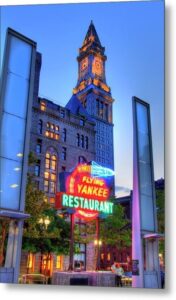For the people of Boston and the far-flung residents of Red Sox Nation, the iconic CITGO Sign near Fenway Park possesses powers both sentimental and powerful. Restored, protected and upgraded, it dominates Kenmore Square and appears on tee shirts, in memes, and in the press. The CITGO Sign has become an unofficial mascot of the Boston Red Sox.
My favorite neon sign in Boston, however, disappeared decades ago. Once, the White Fuel Sign rose from the roof of the Buckminster Hotel and faced the Cities Service Sign that later became the CITGO Sign. It was one of three oil company signs in Kenmore Square, along with a Gulf sign that rose where Boston University is now.
While both White Fuel and Cities Service advertised oil companies and both were automated, I always preferred the White Fuel sign.
A Sparkling Gusher
This neon advertisement provided us with a deceptive view of an oil derrick, one that converted a gusher of black oil to a sparkling fountain.
First, the derrick lit up in white; then a blue gusher shot into the air. It curved over to the right and filled up the letters that spelled out “White.” After that, the words “Fuel” and “Corporation,” blinked on in cursive.
A separate, non-automated, sign beneath the big one said, “A Leader in New England for Over Forty Years.”
The White Fuel Company
The origins of the White Fuel Sign go back farther than you may have thought. John R. White & Sons Coal Company was started in Providence in 1864, when Abraham Lincoln was president. It soon became one of the largest distributors of coal in Rhode Island. In the 1930s Samuel White added fuel oil to the company’s products and changed the name to White Fuel Company.
The White family sold the company to long-time employee Harold Gower in 1946. When Harold’s son Richard (Dick) returned from College in 1960, he took over the company. Over the next forty-six years, Mr. Gower grew the business through sales and marketing as well as through 17 acquisitions.
On Valentine’s day in 2007 White Fuel sold their assets to Griffith Energy Services. Thus, the company outlasted the sign by decades.
The White Fuel Sign’s History
The sign began its life in the 1940s atop the old Westminster Hotel at the southwest end of Kenmore Square. We can see it under construction in the photo below. If not within home-run distance of Fenway Park, it was a lot closer to the left field wall than the Citgo Sign.

Kenmore Square in 1940 with Cities Service (right), White Fuel (center) under construction and Gulf in the distance Photo: CITGO
The Westminster Hotel later became the Hotel Buckminster and the sign persisted. It was still extant when I went to Northeastern University. The sign made oil look clean and attractive but I loved watching the light rise up, fall over, and fill up the letters over and over again. It was so much more interesting than the Citgo Sign’s in-out pattern.
The Neon Boneyard
The White Fuel Sign was demolished in the early 1970s after I had left Boston. When I returned, only the Citgo Sign remained. Few people now remember the old neon advertisement, but it was one of many iconic neon signs that once lit up the Boston skyline.
Not everyone likes neon advertising signs or think they improve a city. Neon signs were once ubiquitous in the 1930s but fell out of favor in the more sophisticated 1970s. I consider many of them to be kinetic art with hand-made tubing and they add life, color and movement to a city. They even buzz.
Las Vegas, home of the country’s most oversize, garish, and tacky neon signs, preserves many of their old outdated ads in the Neon Boneyard Museum. The collection celebrates “the history of Las Vegas through neon.” You can visit and even get married there.
A Neon Second Life
Boston doesn’t have a neon boneyard, much less a museum. Granted, New England’s difficult climate does not support that sort of thing. Neon stacked in an open-air museum like the one in Las Vegas’s Mojave Desert would not last long. Housing any number of the signs would require a very large building like MassMOCA. Even then, I’m not sure the White Fuel Sign would have fit.
Last year we did get an exhibit of iconic local neon on the Rose Kennedy Greenway and I loved it. Signs for the old European, Fontaine’s Chicken, and Flying Yankee restaurants lit up again. State Line Potato Chips, The Cycle Center of Natick, and GE Radio all got a second, if temporary, life. The exhibit added a real pop to the Greenway after dark and I loved driving past.
Where Have They Gone?
Where are the rest? In future posts, I will try to pay attention to some other neon signs, both extant and long gone. I know what signs I remember but which signs were your favorites? What neon (probably flexible LED lights) ones do you like now? And which ones do you miss?
I would really like to know.
NOTE: Why were there so many signs for gasoline and oil companies in Kenmore Square? The reason might be that someone wishing to purchase a car would most likely go through the square to reach the section of Commonwealth Avenue in Allston that was known as Automobile Row. You can learn more about this early version of the AutoMile on HUBhistory’s podcast #180: “Ghosts and Shadows of Automobile Row with Ken Liss.”




